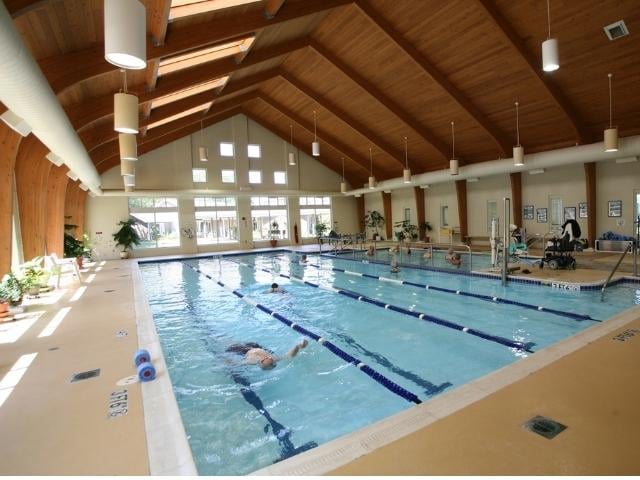Published: October 3, 2023

Yes, Ohio’s outdoor pools are closed for the season but indoor swimming in the Buckeye state is year-round, which means you can continue to enjoy your swimming routine and reap all its health benefits. Among other pluses, swimming provides low-impact cardiovascular exercise, boosts mood, reduces stress and contributes to better sleep. It also can relieve arthritis discomfort and reduce diabetes symptoms.
“People report enjoying water-based exercise more than exercising on land. They can also exercise longer in water than on land without increased effort or joint or muscle pain,” according to the Centers for Disease Control and Prevention.
Given that, let’s take a deeper dive and explore other water exercises besides swimming.
Jump in the Water and Start Moving
Aquatic exercises have many of the health benefits of swimming, plus you can participate even in you don’t know how to swim by wearing a flotation belt or vest. Many health and fitness centers offer water exercises classes so you get the added benefit of socialization, maybe even making new friends.
You might want to invest in water shoes, along with a kickboard, noodle and water weights, though those and other props are often available at the pool.
Here are 3 water exercises suggested by Mayo Clinic to get you started:
- Walk in water about waist high, swinging arms like you do when walking on land. Keep the back straight and avoid walking on tiptoes.
- Once comfortable, try walking in deeper water. To help you stay above the water, try placing a water noodle between the legs, making sure the noodle is higher in back than in front. For a more intense workout, try jogging in deep water.
- For arm exercises, start with your arms at the sides. Grip the bars of the water weights with the palms facing up. Raise the forearms to the level of the water, keeping the elbows close to the body and the wrists straight. Then turn the barbells over so that the palms of the hands face the bottom of the pool. Push the hands down until the arms are straight again. Repeat 12 to 15 times or until you're tired.
Water-based activities especially in warm water can also help relieve pain associated with arthritis and improve range of motion, according to the Arthritis Foundation.
A few tips from the Foundation:
- Be sure the part of your body you’re working on is submerged in water.
- Start slowly and gently and work up to more intense movements as you get warmer. If you’re in a class, your trainer will make sure you warm up and cool down.
- Check with your local YMCA or rec center. They often offer free or low-cost classes for kids and adults.
Water-based exercises at Kendal at Oberlin
Kendal has two indoor pools - a 4-lane lap pool and a warm water therapy pool - and offers a variety of water-based classes for residents. The classes, along with the fitness center, are also free for staff, one of the many benefits of working at Kendal.
Kendal Fitness Instructor Donna Boucher, who leads several water exercise classes at Kendal (preview some of her classes in the video below), explains the benefits:
“Shallow water fitness is typically performed in water that ranges in depth from mid-rib cage to mid-chest. This provides the benefits of both reduced impact and grounding forces and allows participants to maintain proper alignment and control their movements. By using the properties of the water, exercising in shallow water allows for a wide variety or programming that can positively influence cardiorespiratory fitness, muscular strength, endurance, and flexibility. Shallow water fitness is different than land-based exercise because it provides resistance in every direction of submerged movement and has significantly less impact. Several shallow water moves include narrow jog, wide jog, straight leg kicks, leg curls, pendulums, cross country ski, or jumping jacks to name a few.
Deep Water fitness is defined as an exercise program performed suspended in water that allows the participant to remain vertical using a deep-water belt for flotation which allows the participant to concentrate on working against the drag properties of the water opposed to trying to stay afloat. Two things make deep water different that shallow-water exercise: the level of immersion and lack of contact with the pool bottom. The body can move more freely but also requires a lot of core stabilization, so it is important if the feet pop up to the surface that the participant is able to get them back down and their body in vertical position. Deep water running, jacks, cross country skis, leg curls, knee lifts, ankle reaches, and flutter kicks are a few favorite moves to try.”
 One Kendal water-enthusiast is Michele Tarsitano-Amato, director of Creative Arts Therapy. As Michele (photographed in before and after image on the left) explains:
One Kendal water-enthusiast is Michele Tarsitano-Amato, director of Creative Arts Therapy. As Michele (photographed in before and after image on the left) explains:
“I have been on a weight loss and personal health journey this year. For me, I needed the assistance of medications to help my body fight obesity. While the medications helped combat the fat, brought down my sugars and my cholesterol, it did nothing to help build muscle or provide me muscle flexibility. A couple of staffers encouraged me to join their Tuesday/Thursday water aerobics class with Donna Boucher.
WOW has the class made a difference in how I feel about being in my body! I am NOT an exercise person. I’m a doer, and if in doing I am also exercising, well then, I like to get my exercise from performing a skill or pulling weeds, or playing a sport, but to go running for the sake of running, going to the gym…nope, not me! But this class keeps my attention. Donna brings high energy and excitement. She pays close attention to those of us in the class and sees what we respond to. Donna mixes up the exercises so you don’t get bored with the routine. She provides us opportunities to challenge ourselves to the level we wish to exert.”
I have found that I have greater strength in my arms, my knees and joints don’t hurt after the class, and my coordination and body awareness are more accurate. Through laughter and comradery with Donna and my classmates, I have improved my muscle strength and endurance. I still have a long way to go, but that journey is much shorter since gaining the support of Donna and my classmates.
Free Guide: 10 Best Practices for Staying Healthy After 60
In our free guide, we share many actions you can take to live a long, healthy and happy life in body, mind and spirit!
 In the past, Molly Kavanaugh frequently wrote about Kendal at Oberlin for the Cleveland Plain Dealer, where she was a reporter for 16 years. Now we are happy to have her writing for the Kendal at Oberlin Community.
In the past, Molly Kavanaugh frequently wrote about Kendal at Oberlin for the Cleveland Plain Dealer, where she was a reporter for 16 years. Now we are happy to have her writing for the Kendal at Oberlin Community.
About Kendal at Oberlin: Kendal is a nonprofit life plan community serving older adults in northeast Ohio. Located about one mile from Oberlin College and Conservatory, and about a 40 minute drive from downtown Cleveland, Kendal offers a vibrant resident-led lifestyle with access to music, art and lifelong learning.




